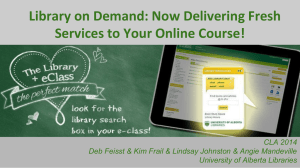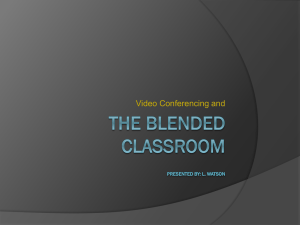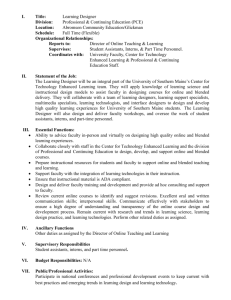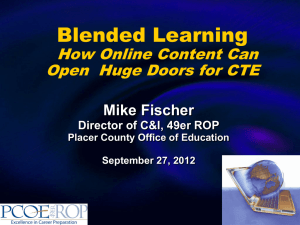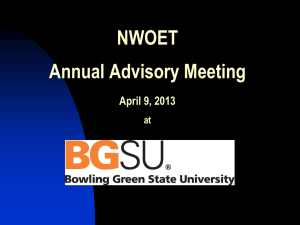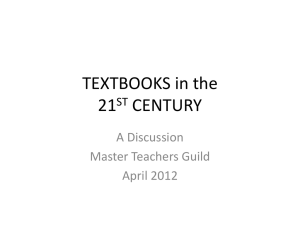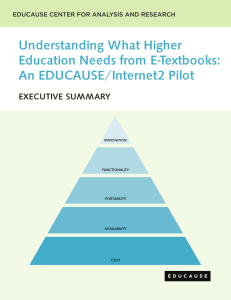Conference Abstracts - CNIE-RCIE
advertisement
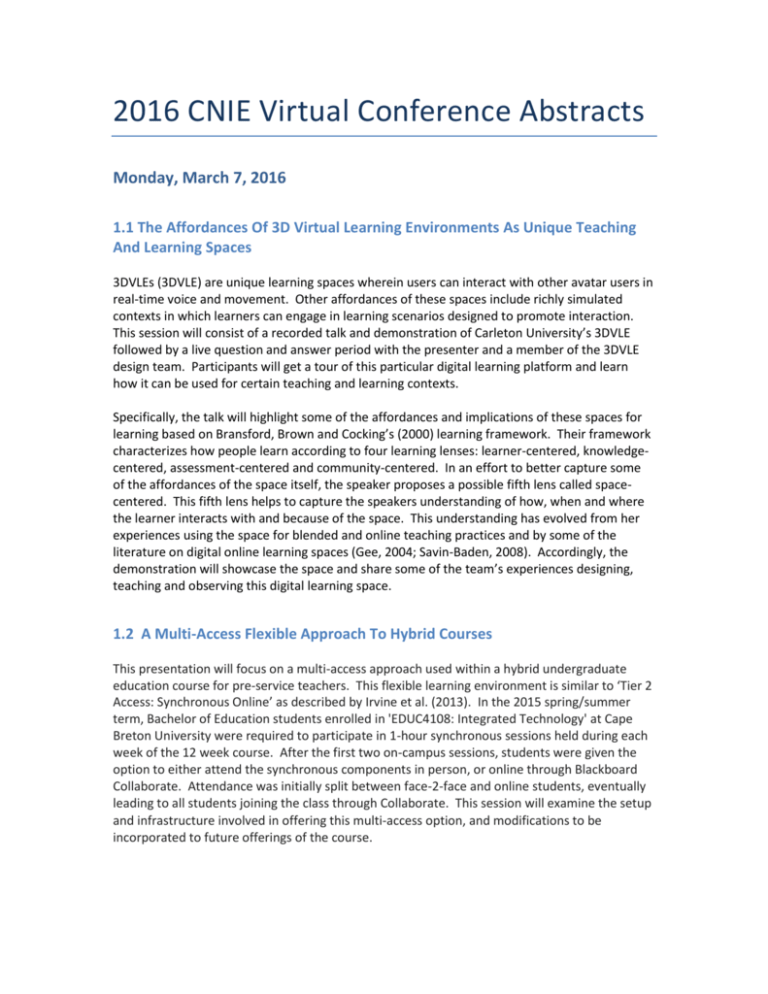
2016 CNIE Virtual Conference Abstracts Monday, March 7, 2016 1.1 The Affordances Of 3D Virtual Learning Environments As Unique Teaching And Learning Spaces 3DVLEs (3DVLE) are unique learning spaces wherein users can interact with other avatar users in real-time voice and movement. Other affordances of these spaces include richly simulated contexts in which learners can engage in learning scenarios designed to promote interaction. This session will consist of a recorded talk and demonstration of Carleton University’s 3DVLE followed by a live question and answer period with the presenter and a member of the 3DVLE design team. Participants will get a tour of this particular digital learning platform and learn how it can be used for certain teaching and learning contexts. Specifically, the talk will highlight some of the affordances and implications of these spaces for learning based on Bransford, Brown and Cocking’s (2000) learning framework. Their framework characterizes how people learn according to four learning lenses: learner-centered, knowledgecentered, assessment-centered and community-centered. In an effort to better capture some of the affordances of the space itself, the speaker proposes a possible fifth lens called spacecentered. This fifth lens helps to capture the speakers understanding of how, when and where the learner interacts with and because of the space. This understanding has evolved from her experiences using the space for blended and online teaching practices and by some of the literature on digital online learning spaces (Gee, 2004; Savin-Baden, 2008). Accordingly, the demonstration will showcase the space and share some of the team’s experiences designing, teaching and observing this digital learning space. 1.2 A Multi-Access Flexible Approach To Hybrid Courses This presentation will focus on a multi-access approach used within a hybrid undergraduate education course for pre-service teachers. This flexible learning environment is similar to ‘Tier 2 Access: Synchronous Online’ as described by Irvine et al. (2013). In the 2015 spring/summer term, Bachelor of Education students enrolled in 'EDUC4108: Integrated Technology' at Cape Breton University were required to participate in 1-hour synchronous sessions held during each week of the 12 week course. After the first two on-campus sessions, students were given the option to either attend the synchronous components in person, or online through Blackboard Collaborate. Attendance was initially split between face-2-face and online students, eventually leading to all students joining the class through Collaborate. This session will examine the setup and infrastructure involved in offering this multi-access option, and modifications to be incorporated to future offerings of the course. 1.3 Flip it Good! Flipping the LMS with an Open and Collaborative Platform Do you have unmet pedagogical goals due to the constraints of your current LMS? Do you want to have a better experience for your students and yourself? In preparing his Fall 2015 CMPT-363 (User Interface Design) course at Simon Fraser University, instructor and interaction designer Paul Hibbitts faced these same challenges. His solution was to 'flip the LMS' by designing and developing an alternative front-end to the institutional LMS Canvas (http://paulhibbitts.net/cmpt-363-153/). In this approach, the LMS was used only for elements it was best suited for (i.e. student records, grades, etc.) with all other elements handled by an open extensible platform completely under his control. Based on the positive feedback of his students and his own experience, he decided to create an open source course companion built with the CMS (Content Management System) Grav to help other instructors get started in flipping their LMS with an open and collaborative platform. In this presentation Paul will share his flipped-LMS approach and introduce his ready-to-run open source course companion for use by other educators. 1.4 Virtual Lab: A Blended Learning Approach to Chemistry Labs A major challenge facing many educational institutions is limited lab time for post-secondary students. Over the course of the 2015-2016 academic year, University of Ontario Institute of Technology (UOIT) faculty and Teaching and Learning Centre (TLC) staff collaborated to create a series of videos designed to maximize the value of student lab times by delivering content and instruction online. This session will provide background on the origins of the initiative, a rationale for its design, and the added value for faculty, lab instructors, and students as a result of the project. Sample videos will be provided, as will discussions necessary for planning, producing, and delivering video content. The primary focus of the presentation will be on how facilitators of postsecondary education can use a blended approach to learning that will both enhance the student experience and solve issues with limited lab time. Additionally, there will be a focus on best practices when creating video and the process of producing and delivering high-quality material that is of value to today's students. Topics covered will include; pre-production (storyboarding), production and equipment, post-production (editing and exporting), and delivering video content (Blackboard, YouTube). Participants will be invited to engage in a dialogue with the presenters regarding their experiences as designers / facilitators of these laboratory experiments and videos. It is our goal to demonstrate to participants the value of blended learning in a post-secondary setting while providing a blueprint for the creation of video content. 1.5 Lecture Recording Playback Analysis Lecture capture, also referred to as lecture recording, is a general term for a wide variety of techniques to maintain artifacts of classroom activity and distribute them to students. Providing students the ability to control recording playback has been shown in previous studies to: improve efficiency; allow students to relax in lectures; review elements that they may have missed in the live lecture; and be optimal resources for review and exam preparation. Based on the observations in the research as to the benefits of lecture capture, this author has been recording all of his class lectures and demonstrations for approximately five years, originally using the Blackboard Collaborate application. For the past year, all of the author’s classes have been recorded in Google Hangouts and preserved as YouTube videos on the author’s YouTube channel. Beyond better playback control, YouTube provides built-in analysis tools for channel owners to track their viewership patterns. While these tools are mostly intended for revenue-generating content creators to track their viewership demographics and viewing patterns, the current author has endeavored to determine their usefulness for answering the following research questions in an educational setting: 1. How do students access class recordings? 2. When do they access class recordings? 3. What parts of the recordings do they watch? Tuesday, March 8, 2016 2.1 A Blended Approach to Apprenticeship Training Greg Ryan will show how technology and innovative methods are used to create an engaging multi-site classroom; even individuals in remote areas will be ”a part of the class" not simply watching a class take place. This presentation will illustrate how innovative delivery methodologies can lead to astonishing student pass rates of high stakes exams, and how providing greater access to education can promote the reactivation of apprentices. Get a full understanding of how Greg’s blended learning classroom has been more successful than a traditional classroom setting and the reasons it has received two National and two International Awards. This presentation will give the audience further insight into the technology that we have thrown into the blender here at CNA. The use of a video conferencing suite, which provides the ideal ‘open window’ between the two classrooms, allowing the instructor to not only monitor the apprentices’ attempts at solving physical problems, but to monitor their demeanor for signs that they may need assistance. Clickers are used daily to transmit student responses over the internet, which we use to enable apprentices from both locations to interact and learn from each other and the instructor. Bridgit™ conferencing software allows SMART Board™ interactive whiteboards in each location to display exactly the same material - in real time - with seamless interaction between sites. Finally, D2L playing a supporting role in formal assessment, dialogue, additional content and more. 2.2 K-12 E-learning: Story of a Virtual School E-learning at the K-12 level was introduced in 1990s. Since then, its growth increased very quickly, and still continues to increase. Most states in the US and many jurisdictions in the United Kingdom, Australia, Canada and New Zealand have their own virtual schools. There are more than 250 schools that offer K-12 online distance education in Canada. Some provinces have one program while others have more than one program depending on the students' enrolment and need for distance courses. Due to the rapid proliferation of digital technologies and their use in education especially in virtual schooling, it is significant to know how these programs are operating. There is a lack of literature that indicates the characteristics of such programs and schools. The researcher has outlined a research strategy to describe the story of a virtual school. In this presentation, the researcher is going to present the objectives, and significance of his research project. The researcher will also outline a research methodology, research questions and procedures of participants' recruitment. The purpose of this presentation is to optimise participants' understanding of the historical development of virtual schooling in one province of Canada. 2.3 Blended Learning: Shaking Up The Student Work Experience The Bachelor of Arts Community Studies (BACS) degree was the first degree granted by CBU and over the past 40 years has been a successful model of integrated community engagement. In each of the 2nd and 3rd years there is work experience placement required. Originally set up as on-the-job training and a means to connect individual students with an individual vocational experience, thus differentiating it from a conventional BA degree, these two placement courses have set a high standard for not only sending students out of the classroom, but also demonstrating many good practices for experiential and service learning. The work experience placements are part of the process of engaged learning embedded in the BACS degree and they reflect the ideas of engaged scholarship as described by E.L. Boyer and his colleagues at the Carnegie Foundation for the Advancement of Teaching in the US. In Boyer’s work we see the scholarship of engagement defined as: “ the scholarship of engagement means connecting the rich resources of the university to our most pressing social, civic and ethical problems, to our children, to our schools, to our teachers and to our cities… But at a deeper level it also means creating a special climate in which the academic and civic cultures communicate more continuously and more creatively with each other… enriching the quality of life for all of us (Boyer, 1996). As the work experience placement has been refined it has gone from an individual experience, whereby a single student is adrift in the work force, with a work supervisor and only individual connections to CBU; it is now amore cohort/community-based model whereby a classroom component was added to connect the placement students to each other. This was further refined when in the Fall of 2015 the classroom became virtual. Students now complete a 10 module online course that connects them to scholarly resources and their peers, while they complete their 100 hours of hand-on experience. This presentation will offer insights into how the virtual world and the real world intertwined in a work placement context. 2.4 E-Textbooks: How Do They Work for Mid-Career Learners? As e-textbooks have taken their place in post-secondary education, researchers have explored student attitudes to e-textbooks, practices in using them, academic results, and many other topics to better understand their potential impacts. Most researchers have focused on 18-22 year-old full-time undergraduate students enrolled in on-campus studies; scant attention has been paid to e-textbook reception and use by mid-career learners enrolled in online graduate courses. Using a sequential, exploratory, mix-methods approach, this study, now complete, used demographic and attitude surveys followed by 23 telephone interviews to answer this central question: For mid-career learners enrolled in online graduate courses, how are attitudes to, and engagement with, e-textbooks shaped by the circumstances in which e-textbook use takes place? Key factors explored included prior attitudes and experience, e-textbook features, e-reading device, and instructor guidance. Respondents were found to be: computer savvy, but much more inclined to choose printed textbooks over e-textbooks; negative about most of the supposed affordances of e-textbooks; convinced that they learn less from e-textbooks than from printed textbooks; and dissatisfied with the support they received from instructors. Pre-existing attitudes to e-texts were a good predictor of attitudes to course e-textbooks. Women were found to be significantly more likely to hold negative attitudes towards e-textbooks than men. The study concludes that many of the factors contributing to negative attitudes to e-textbooks can be overcome by means of specific corrective actions, which will be highlighted in the presentation. 2.5 Weekly Online Learning Objects for Community Health Nursing Learning objects are web-based tools that contain interactive learning units. At the University of Ontario Institute of Technology’s Teaching and Learning Centre, multimedia developers help build engaging multimedia components, including learning objects, to enhance the learning experience in online, hybrid and face-to-face environments. In the winter of 2015, a community health nursing course was updated in preparation for a fully online offering of the course. Articulate-Storyline software was used to create twelve learning that were intended to present course content and activities in a variety of formats (introductory videos with the course instructor, text resources, interactive quiz questions, independent activities, additional video resources and discussion questions). The learning objects were developed with consideration of the Community of Inquiry Framework (Garrison, Anderson & Archer, 2000). Therefore, efforts were made to include the three elements of teaching presence, cognitive presence and social presence in each of the learning objects. Moreover, the learning objects are well-organized and present information in an engaging manner within an interactive interface. Providing web-based learning tools in the fully online offering of this course afforded students, many of whom are working professionals, the ability to interact with weekly course content anytime and (almost) anywhere. Since the summer 2015 online offering of the course, these learning objects have been reused in a hybrid manner in face-to-face offerings. This session will provide a brief overview of the process, from conceptualization to evaluation of these learning objects. Thursday, March 10 3.1 Designing for Change: Engaging Faculty through a Blended Certificate in University Teaching Program Following the success of its initial Certificate in University Teaching (CUT) program during the 2014-2015 academic year, University of Ontario Institute of Technology (UOIT) Teaching and Learning Centre (TLC) staff decided to both bifurcate and expand the program for its 2015-2016 offering, creating one stream for faculty and staff and another specifically for teaching assistants (TA’s). This session will provide background on the origins of the program, a rationale for its redesign, and share the constructivist principles of teaching and learning which the program staff sought to use as design elements and also embed as content within the program. Screenshots of the online learning environment (Blackboard) will be provided, as will discussion of the planning, implementation, and delivery of the program. A reflection on lessons learned will also be included. The primary emphasis of the presentation will be on how the program designers / facilitators attempted to model and convey “good practices” in teaching and learning for the benefit of the program participants (i.e. faculty, staff, and grad students) so that participants would feel empowered to experiment, innovate and ultimately try to enhance the design and delivery of their respective face-to-face, blended, and online courses. Participants will be invited to engage in a dialogue with the presenters regarding their experiences as designers / facilitators of these types of programs (and in other CoPs and/or faculty workshops). It is hoped that participants may gain some ideas for use in their respective settings. 3.2 Pilot Findings of a Blended and Online Learning and Teaching (BOLT) K-12 Professional Learning Initiative As ubiquitous access to technology increases in K-12 classrooms, a shift in the way in which learning is designed and delivered is beginning to materialize. In the K-12 education, technology enhanced learning, whether it is a version of blended or fully online is a growing and developing area of education. This trend will likely only increase in the future due to pressure from reduced budgets, changes to educational policy, increased access to technology, better understanding of connectivist approaches to learning and demand from learners. Because online and blended learning is complex and continues to evolve, a need for professional development for in-service teachers within the K- 12 system has materialized. The goal of the Blended and Online Learning and Teaching (BOLT) initiative is to provide a thoughtful response to this professional learning need. In this virtual presentation we will provide an overview of the history of the professional learning collaboration between Athabasca University’s Centre for Distance Education and the Alberta Distance Learning Centre ( ADLC). The development of curriculum, the implementation plans for 2015- 2020, and a discussion of research possibilities will also be covered. With half of the professional learning modules of the pilot offering having been completed, initial findings will be discussed and add the depth of participants’ lived experiences to the presentation. 3.3 The Intel Program and Its Impact on Saudi Students’ Learning By 2007 the government of Saudi had invested about 3 billion US dollars in “Tatweer Program” that includes the information and communication technologies (ICT). In 2014 the Ministry of Education received again about $2.5 billion US dollars for the same project (MOE, 2014). The “Tatweer project” is for developing education in the kingdom of Saudi Arabia. It focuses on four elements: the developing curriculum, teacher training, technology integration, and nonclassroom activities. (MOE, 2008; Tatweer, 2014). The Intel program innovation “Intel Teach To The Future” was introduced to Saudi education to train teachers on integrating technology into teaching and learning. Intel supplies training for teachers and both hardware and software to the nation. The English language learning took a place in the Intel program. In English language learning, teachers were trained to enhance English language skills (reading, writing, speaking and listening) through the Intel program. In this qualitative research, a case study investigates the effectiveness of the Intel English language learning program on the reading and writing skills of Saudi male adolescent students. It took place in Saudi Arabia, Makkah City, where educational technology was recently introduced to facilitate teaching and learning. This study involved 26 participants, from Makkah City, including 10 teachers, 10 students, and 6 administrators of education. The researcher used face-to-face interviews to collect the data. The researcher transcribed the interviews then analyzed it thorough coding the interviews. The results of this research found five major issues, including Intel issues, Administrative issues, Social issues, Training issues and Teaching practice issues. These issues are discussed in this presentation. 3.4 Supports, Barriers, and Online Learning Preferences of Indigenous University Students The 2011 National Household Survey census in Canada revealed that only 9.8% of Indigenous people had completed a university degree, compared to 26.5% for the general population (Statistics Canada, 2011). The main purpose of the research presented here was to identify strategies that could increase the completion rate of Indigenous students taking online courses. First, we needed to identify the supports, barriers, and online learning preferences of Indigenous students. Twenty online Indigenous undergraduate students were interviewed in person, two talking circles were held, and 232 completed an online survey. Unique to the survey was the use of video vignettes that demonstrated a variety of online learning options the benefit of students who had limited online learning experience. Watch this video, which shows a student interacting with content while immersed in a virtual environment that is culturally significant to the student. 41. 42. 43. 44. 45. 46. Please circle the number that best describes your view: I have the computer skills to do this activity. This activity would help me to: participate in group discussions build relationships with other students support other students in their learning work hard to complete the course create a positive social environment Strongly Disagree 1 1 1 1 1 1 Disagree Undecided Agree 2 3 4 2 2 2 2 2 3 3 3 3 3 4 4 4 4 4 Analyses of supports and barriers found that tutoring, technical skills, personal motivation, computer skills, and social environment were significantly related to course success (grade). Students were most experienced using texting, Facebook, and chat and least experienced using blogs, twitter, and wikis. Preferred online course elements included the use of graphics, embedded media, collaborative online software, and virtual environments. Least preferred course elements included group projects and audio recordings of lectures. Preferred communication with instructors was the use of email and least preferred was phone call with instructors or students. 3.5 A Sustainable Model for OER Lyryx Learning was first created out of the University of Calgary more than 10 years ago to develop (formative) online assessment for our students, at that time supporting content from a large publisher. More recently, and realizing the immense potential of Open Educational Resources (OER), Lyryx is engaging authors of OER textbooks directly to create products and services under the new "Lyryx with Open Texts" brand name. Aiming at a sustainable business model, Lyryx offers the textbooks to students at no cost, while a fair license fee is charged for the use of the online assessment in exchange for student and instructor support, editorial services to adapt the content, and all other needed supplementary material. We will discuss this initiative and recent experiments to make the license fee optional. Strongly Agree 5 5 5 5 5 5


